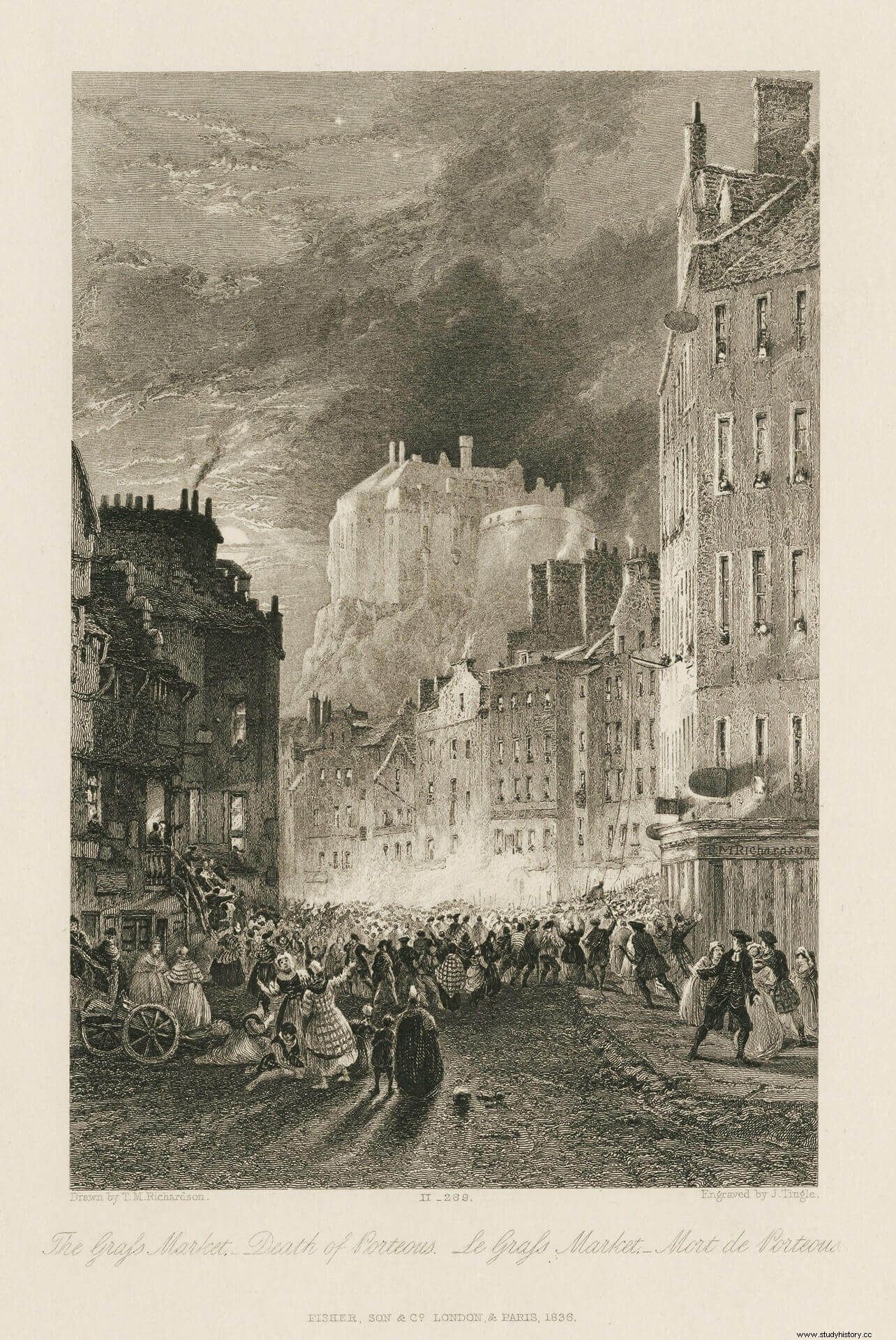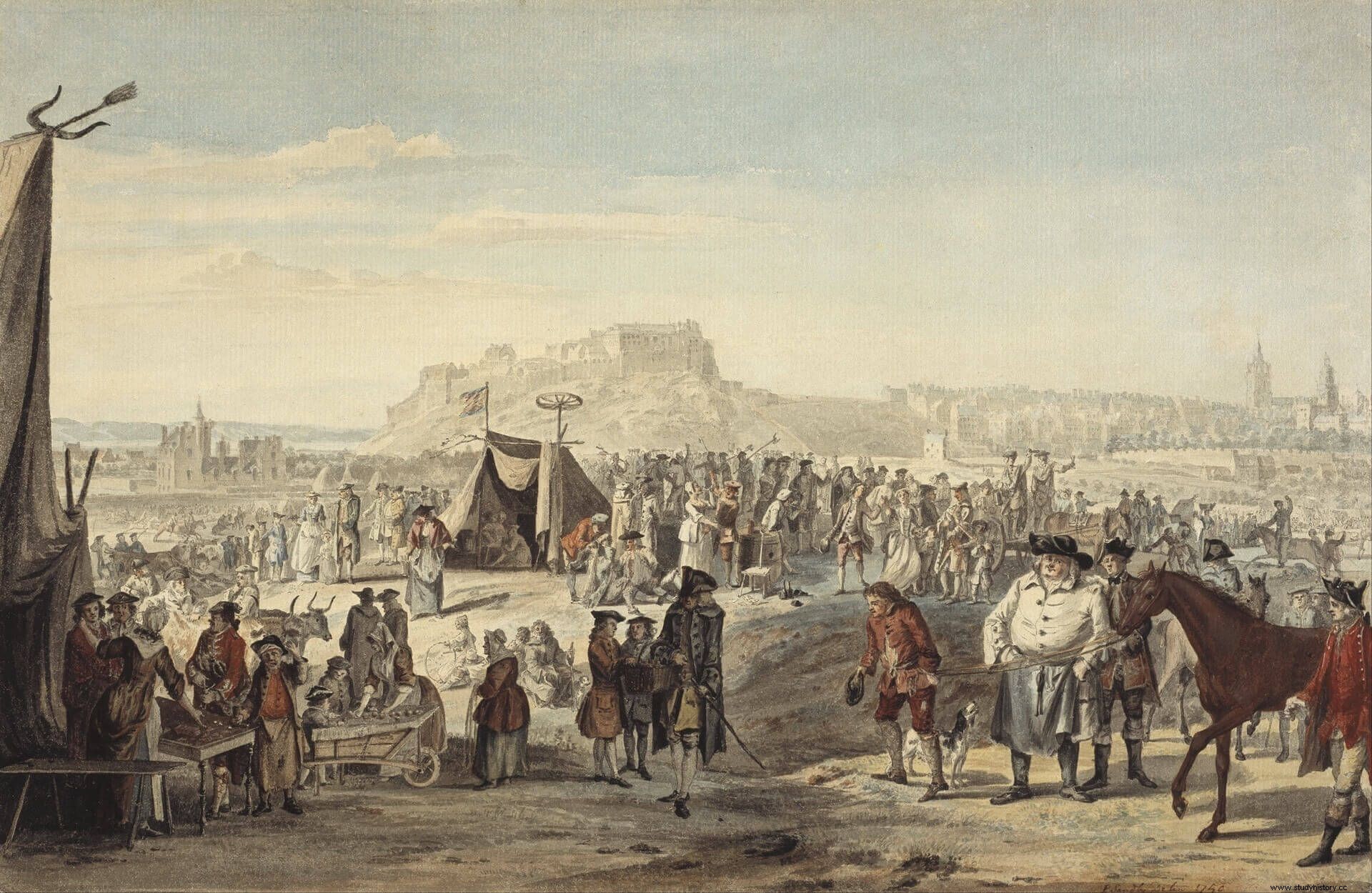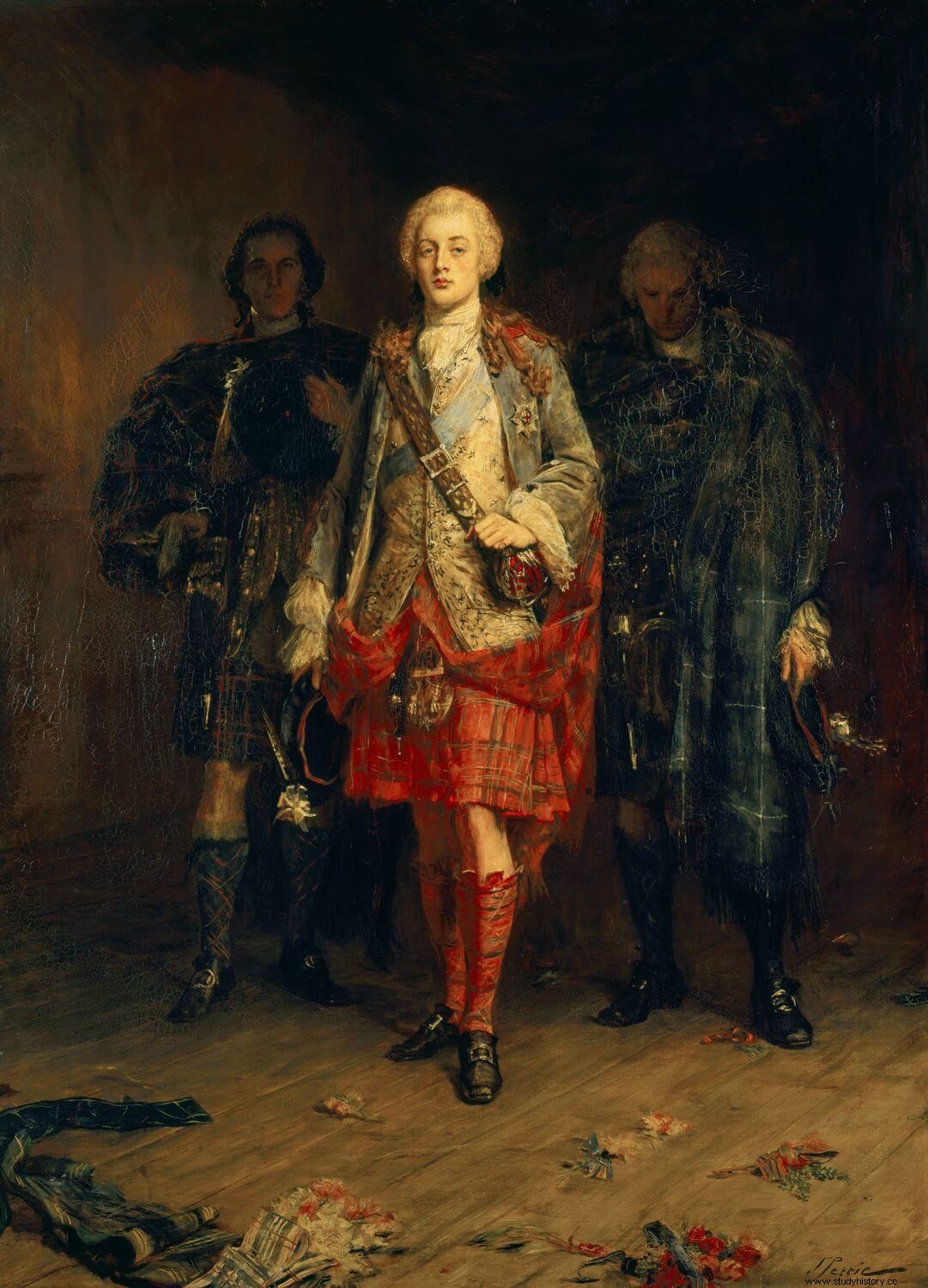
The Stuart royal house she was the rightful trustee of Scotland in the same way that the Highland chiefs and Lowland heads of families were, by custom, the protectors of her kinsmen. Dynastic legitimacy was perceived as the source of justice and the basis of government, but both were threatened in Scotland by the breakdown of dynastic continuity, first by William of Orange and the Glorious Revolution against James VII of Scotland and II of England, between 1688 and 1691, and then for the succession of the House of Hannover with George I in 1714.
In Scotland, adherence to Roman Catholicism was a minority. confessional loyalty of the Jacobites, especially its Highland and north-eastern cores, was overwhelmingly Protestant, but Episcopalian. During the Glorious Revolution, Episcopalianism (the rule of the bishops) had been removed from its position as Kirk of Scotland [N. del T.:name given to the Church of Scotland in the 17th century] in favor of Presbyterianism (governed by ecclesiastical courts). A minority of Episcopalians were willing to seek a compromise to ensure religious toleration, first with William of Orange and his successor Queen Anne, and later with the Hanoverians. The venues where these Episcopalians met – known as “jurors” – became outposts of the Anglican Church of England. The refusal of the overwhelming majority of Episcopalians to abjure the exiled House of Stuart subjected them, like Catholics, to the penal laws.
The impulse of Jacobitism
After the Treaty of Union of 1707 Scottish Jacobitism needed not only a new impetus, but also a new direction. Patriotism, no less than dynastic loyalty, became its driving force and was part of the process of continual redefinition of Jacobitism in Scotland, something that was not always to the liking of the House of Stuart. This process was based on a concept of homeland founded by humanist teaching, specifically by neo-stoicism. The identity of the Scottish people was expressed through the momentous achievements of scholars, soldiers and adventurers as much as those of their monarchs. Patrick Abercromby and George Mackenzie, both with strong family connections to Jacobite nuclei, conceptualized the "fatherland" just after the Union to point out that territorial nationality should take precedence over the dynastic state. At the same time, Jacobitism could take advantage of the opposition to the Union to end the political subjection of Scotland. Nationalism, which can be identified with Scottish Jacobitism in the eighteenth century, was a powerful mixture of patriotism and general grievances caused by the misrule of Scotland after 1707.
The first sample of bad government occurred in the initial British Parliament, in 1708, with the approval of an act to strengthen the Union that consisted of three measures that were made evident in Scotland the nature of political incorporation:the first was the establishment of a Revenue Court for Customs and Excise Duties, to ensure that English tax regulation and administration were extended to Scotland; the second was the imposition of the Treason Act in Scotland to facilitate the conviction of the Jacobites; and the third was the abolition of the Scottish Privy Council. Suddenly, Scotland was deprived of its central executive, thus losing the powers of judicial and administrative supervision.
In addition to the administrative dismantling, there were other violations of the spirit of the Treaty of Union, if not the text, with regard to politics and economics. When the British Government raised the malt tax in 1713, before the end of the War of the Spanish Succession, indignation spread among the Scots. The Treaty of Union had specifically excluded any increase in the malt tax in times of war. More important still was the equalization of tax rates, which worked to the detriment of Scotland. The irritation was such that leading Scottish politicians who had actively supported the Union began to work closely with those who had opposed it. The motion that was debated in the House of Lords in 1713 was not intended to dissolve the Union, but to instigate formal debate towards the same end. The Union was saved by four votes.
Persecutions and riots
The Union had survived by a very narrow margin. Two years later, the Jacobites were defeated, with victory close at hand, in the great rising of 1715 to 1716 known as “el Fifteen”. However, Scottish indignation against the British Government was revived after the punitive treatment meted out to the Jacobite leaders, who were deprived of their property, rather than by legal process, for the loss of their rights. Members of the Forfeited Estates Commission were prepared to override all interest to ensure a financial return to the British Government, despite protests from the Scottish judiciary and leading politicians. The members of the commission encouraged London speculative interests to buy Jacobite estates in order to dispossess the owners of forest and mining rights. However, the Scottish Jacobite elite were sufficiently well connected with their Hanoverian counterparts that preventing the complete ruin of the landed families, as well as their trading partners, became a national determination; so when the estates of chieftains and leading nobility were confiscated, their clansmen made sure to thwart, more often than not, government efforts to sell them to other Scottish landowners or newly arrived adventurers. Chiefs and aristocracy continued to collect rents in exile, and after a decade of civil disobedience, unsold properties were returned.
The threat of riots, which had led the British Government to postpone raising the malt tax in 1713, became a reality when the tax was revised in 1725. The most notorious protest it occurred in Glasgow, where a mob swept through Shawfield Manor, though incompetent management by the military aggravated the disorder. The British Government blamed the magistrates and the Council, who were punished with a fine by the Scottish judiciary. General George Wade, sent from England to restore order, continued to impose a military occupation of the Highlands to contain Jacobitism, which, in fact, had not even made an appearance.
Nine years later, the Edinburgh City Guard opened fire on a crowd trying to free an imprisoned smuggler. The crowd regrouped and the captain of the guard, John Porteous, was captured and lynched. The political resonances were less pronounced than after the Shawfield riot and order was restored without any punishment for the magistrates or the City Council. The “Porteous riots ” were rather attributed to a lack of coordination between the military and the Scottish judiciary. No Jacobite presence was detected either, although British governments continued to fear their association with smuggling.
Between the Treaty of Union and the rising of 1715, the Jacobites lacked a permanent national organization that, during the 1720s, focused on exploiting the continuing unrest against the Union instead of limiting himself to reporting to the Jacobite court, exiled in Rome. After a hiatus of twelve years, a Scottish Association of Jacobites was formed in 1739 , six years before the last great uprising, from 1745 to 1746. Liaison with the court of Rome through unreliable agents weakened his political credibility and severely hampered preparations for the uprising of 45. Even among the clans, the backbone Scottish Jacobite military, there was a marked loss of support. In 1715, twenty-six of the fifty major clans mobilized, but no more than nineteen did so in 1745. The clans willing to fight for the Hanoverians remained fairly constant:eight in 1715 and seven in 1745. The politically divided clans grew from five in 1715 to twelve in 1745. These figures reflect not only the diminishing appeal of Scottish nationalism but also the gradual growth in Scotland of British patriotism and unionism.

British patriotism and economics
In 1728, David Scot had emphasized that Scottish Jacobitism did not have exclusive rights to patriotism. This author wrote a historical reply to the works of Abercromby and Mackenzie and redefined the “homeland” with a British identity . It is clear from the subscription lists for the works of these three authors that the Scottish 'homeland' was attractive regardless of the political divisions between Jacobites and Hanoverians. Enlightenment figures supportive of the House of Hanover, such as Adam Ferguson, emphasized the rights and freedoms shared by the British. His efforts to align Scottish Presbyterianism with British patriotism were undoubtedly shared in the majority by the clergymen of the Kirk , who not only served Hanoverian interests from the pulpits, but also in their careful policing of Jacobite activities.
This recast of patriotism coincided with the late payment of modest development funds promised in the Union and jointly channeled by the British Government through the Board of Trustees for the Fisheries and Manufactures and the newly founded Royal Bank of Scotland. The Bank of Scotland, established in 1695, was not trusted due to its known association with Jacobitism in the past. Limited venture capital was applied primarily to improving manufacturing standards for flax and, later, for wool. Sheep-farming districts in the Jacobite core of the Highlands and North-East were excluded from financial compensation. The British government gave Scottish businessmen little motivation to maintain the Union and the Hanoverian succession, thanks to the granting of generous rebates for linen exports in the early 1740s.
The transport of cattle grew considerably in the years after the Treaty of Union, when unrestricted access to expanding markets transformed London into an imperial metropolis, the largest city in Europe, as well as the demand for beef for ships and the growth of industrial cities of England. Cattle transportation had a negative impact by encouraging absenteeism, debt accumulation, and increased rents for clan leaders and nobility; but it also proved to be a positive stimulus for competition between the two national banks, which financed commercial enterprises from credit rather than safe funds, something that attracted investment from England. This dividend from the Union, which undoubtedly benefited textile manufactures and fishing, also translated into an imperial dividend with funds available for exports of linen and wool directly to colonial markets. British patriotism benefited from Scotland's economic revival as native entrepreneurs seized imperial opportunities in America, Africa and Asia.
The few public offices and positions of power awarded to the Scottish ruling class after 1707 tended to be monopolized by Presbyterians and other committed Hanoverians, rather than Episcopalians or indecisive Jacobites. However, the latter group was remarkably successful when seeking placement in the Empire, largely because of John Drummond de Quarrel's myriad contacts . After beginning his career as a merchant in Edinburgh, this Scotsman settled in Amsterdam as the main provider of funds for the British forces on the continent during the War of the Spanish Succession. After the end of the conflict, he moved between Amsterdam, Edinburgh, Paris and London; he facilitated the recruitment in Scotland of the Royal African Company to further their ambitions in Sierra Leone, Gambia and Angola, and, after settling in London in 1724, helped shape the East India Company. Although he was a Unionist, Drummond had strong Episcopalian and Jacobite connections. With the backing of Prime Minister Robert Walpole he used imperial patronage to rehabilitate the Jacobites and reward the Hanoverians. Until his death in 1740, he was the main promoter of Scottish settlement in India and also exercised a more limited patronage in the West Indies, Virginia and South Carolina.
The appeal of the Empire to Jacobites and Episcopalians was of particular value to the United Kingdom. The interests that sought to end the Union could be neutralized or even won over to the cause. British patriotism and unionism were fully compatible; not so Scottish nationalism and the British ambitions of the Stuarts. This would have serious strategic consequences for Jacobitism in the uprisings of 1715 and, above all, in 1745.
The two great rebellions
Deposed from his position as Secretary of State for Scotland with the arrival of the House of Hanover, John Erskine, Earl of Mar, seized on the need for a prominent leader in the uprising of 1715 , but he failed to channel the general discontent against the Union. After taking Perth, he sent a detachment across the Firth of the River Forth to establish contact with the Scots and English on the border. Instead of joining forces in a pincer maneuver on Edinburgh, the Scots insisted on marching on England and were resoundingly defeated at Preston on November 13, 1715, the same day that Mar suffered a decisive defeat at Sheriffmuir in central Scotland. .

Jacobitism had a military commander with a touch of genius in the 1745 rebellion, Lord George Murray, who, however, was constantly undermined by a terrible clash of personalities with the charismatic but inept Charles Edward Stuart, eldest son of the exiled James VIII of Scotland and III of England. The prince's failure to establish himself in Scotland before invading England meant a loss of the collective desire to prolong the Scottish campaign after the Culloden defeat , near Inverness, on April 16, 1746. The prince's initial victory at the Battle of Prestonpans, near Edinburgh, on September 21, 1745, followed by the march of his troops south to Derby, resulted misleading The lack of foreign support undermined the confidence of the English Jacobites, and furthermore the Highland dress prevented them from identifying with the prince's Scottish army. When the withdrawal began, in early December, the Jacobite lines of communication were overextended and provisioning was very difficult. On his return to Scotland, his victory at Falkirk on January 17, 1746, was as surprising to them as it was to the Hanoverians. The commanders of the British forces, superior by land and sea, were then convinced that Jacobitism must be annihilated.
Bibliography
- Eriksonas, L. (2004):National Heroes and National Identities:Scotland, Norway and Lithuania. Brussels:Peter Lang.
- Harris, B.; Whatley, C. A. (1998):“To Solemnize His Majesty’s Birthday”:New Perspectives on Loyalism in George II’s Britain . History, 83, pp.397-419.
- Kidd, C. (1996): North Britishness and the Nature of Eighteenth-Century British Patriotism. Historical Journal, 39, pp.361-82.
- Macinnes, A. I. (2007):Jacobitism in Scotland, an episodic cause or national movement. Scottish Historical Review, 86, p. 225-52.
- Sankey, M.; Szechi, D. (2001):Elite Culture and the Decline of Scottish Jacobitism 1716-1745. Past &Present, 173, p. 90-128.
